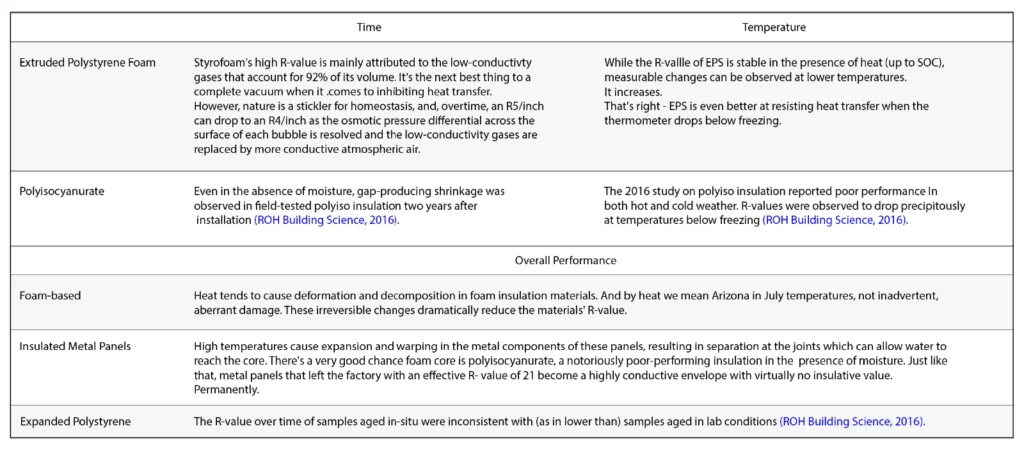As the pursuit of net zero CO2 emissions intensifies, conflicting ideologies seem to be obscuring the path forward for Green Building practices. On the topic of buildings’ full carbon footprint, the focus has shifted from operational to embodied carbon emissions, sparking a debate over which insulative material reigns as the energy efficient and sustainability leader.
It’s easy to recognize the materials that appear to be irrefutably superior in terms of embodied carbon, are prohibitively impractical for large-scale applications and overwhelmingly riddled with inherent operational inefficiencies and resiliency concerns. Spoiler alert: straw bales will not be the underdog hero in this story. Rather than debating if reducing embodied carbon emissions is more impactful than operational CO2, or making concessions on one front in order to dominate in the other — why not aim to balance both? As long as you keep the project’s threshold for diminishing returns in sight, building with the future in mind just makes sense.
Scoring the contenders
Herein lies the rub. Even though most of us would agree to focus on conductive heat transfer and cite effective R-value as the most accurate measure of actual efficiency performance, crucial factors would still be unaccounted for. To get from the material’s R-value to the structure’s effective R-value, we need to expose some hidden pitfalls.
Thermal Insulation Stability
Unfortunately, R-value is not a constant. Even though the FTC’s R-value Rule protects consumers by requiring manufacturers to substantiate heat transfer resistance claims with standard testing, parameters aimed at accounting for in-situ variations (such as temperature differences, settling, density, etc.) don’t necessarily cover the entire gamut. For instance, the parameters for performance over temperature differentials are written in a way that allows manufacturers to avoid verifying R-value ratings below freezing. Hard to believe, right? When you take into account materials with a very high R-value at room temperature often have a different R-value at low temperatures, FTC compliance becomes far less reassuring.
Here are a few of the ways how insulative materials regularly fail to perform as you’d expect:

Thermal Mass
One way to avoid the frustrating efficiency failures associated with thermal instability is to rely on materials with more weight to their R-value ratings. Ba-dum-ching. The dampening effect of heavy materials is no joke, though. Dense materials such as concrete take a long time to transfer heat (ie. kinetic energy), effectively mitigating temperature fluctuations. That’s why stone remains a popular choice for exterior walls in regions where days are warm and nights are cold.
However, master stonemasons take us deep into diminishing returns territory, and high-volume cement pours are an egregious source of carbon emissions. A SIP product that employs low-carbon, cement-based panels such as ZS2’s TechPanel offers a cost-efficient, faster, easier construction solution. The dampening effect of the TechBoard panels significantly increases the EPS core’s already-impressive ability to resist heat transfer.
Thermal Bridging
When it comes to increasing a building’s effective R-value, the importance of reducing thermal bridging cannot be overstated. Precious efficiency gains made by selecting stable, low conductivity insulative materials can be reduced by more than half with the introduction of a small percentage of thermally conductive material.
One way to combat thermal bridging is to choose materials with low conductivity. Innovative stud materials such as carbon fibre composite combine the low conductivity of wood with the strength and weight advantages of metal studs. No wonder it’s on-track to be produced at a scale that should completely supplant the steel stud market in conventional construction.
Alternatively, the effect of thermal bridging can be reduced by decreasing the number of bridges or a staggered stud approach (costly). Building panels engineered to provide the same (or better) structural strength as traditional construction methods with fewer structural members are a solution that also offer the convenience of prefab components. Compared to the conventional 16 to 24 inch span between studs, ZS2’s TechPanels are produced with a span of 48 inches, resulting in a 30 – 40% reduction in thermal bridging.
How To Prevent Unexpected Deficiencies
To some extent, longevity and success in the building industry is a function of how well a firm responds to changes in the market. No matter the source of a shift — be it regulatory changes, progressing societal conventions or the perpetual evolution of design trends, positioning yourself out in front offers a clear strategic advantage over playing catch-up. What does “out in front” mean? Primarily, building for the future is achieved by using innovative materials and methods which produce code-exceeding efficiency and resiliency. It wasn’t that long ago when insulating a wall meant stuffing it with newspaper. In the not-to-distant future, fibreglass batt will be considered equally absurd.
Another way to gain ground is to build for the unexpected. Granted, if any of us could accurately predict the future, there’d be little need to read articles like this. We’d be sippin’ Mai Thais on our private island or buying new jets with Bitcoin. So, again, it comes back to maxing out the distance between your buildings’ performance and today’s minimum codes. Take the cannabis industry, for example. When the surge of producers entered the market, very few existing structures had been built with materials that could withstand ultra-high humidity. Then there’s staying ahead of climate change effects. Even just ten years ago, there’s no way builders in Texas ever imagined a need to fortify their structures against two feet of snow.
Even though you may never look at the R-value on a product label the same again, here’s the good news: it’s highly unlikely that you’ll be blindsided by poor efficiency performance in the future. Aim for the trifecta of effective R-value superiority: high thermal stability, high thermal mass and low thermal bridging.
Click here to see how ZS2’s engineered our TechPanels with this principle to achieve an effective R-value of R-30 to R-40.


